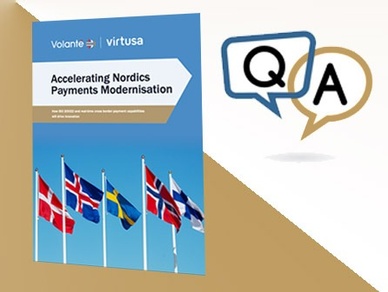Financial payments infrastructures are at the crossroads of global modernisation, with the new ISO 20022 message standard leading the charge. Driven by regulations and market demands for innovation, the transformation to real-time, cross-border banking transactions is fast and furious.
A recent Volante & Virtusa attendee poll found that 63% of respondents plan to strategically leverage payments to create new products and services, followed by 19% who will not participate, and another 19% who are undecided.
I recently had the opportunity to speak on a webinar with Volante’s Peter Larsson, Business Development Director of Nordics to discuss how ISO 20022 and real-time cross border payment capabilities are driving innovation.
Innovation
What is the key driver to innovation?
Peter Larsson: Technology should be an enabler. As technologists, our job is to enable innovation. Innovation starts from the top. Creating a culture of continuous innovation and challenging the status quo should be at the core. It is a fundamental aspect of any business that wants to win, and in the payments industry organizations must support an ‘innovate or perish’ mentality. Having said that it is easier said than done, as in any organization you will always encounter the fear of change or resistance.
Strategy
In regards to modernising your payment systems, would you suggest a phased approach, an all-in approach, a big-bang approach?
Peter Larsson: It will be a big journey, whichever way you choose. Starting off on the right foot and with the right strategy laid out is very, very important, I think. You first need to understand strategically what you want to do upfront. Do you want to enable your data connections? Do you want to enable innovation? Do you want to enable the data coming from the cloud? Do you want to cut costs and bring in automation? Those strategic decisions must be understood first. The ability to go-to-market is very important along with being agile. From a bank perspective, it is also highly recommended to choose what kind of product and services that banks need to remain competitive and deliver beyond customer expectations.
Remaining Competitive
Would you say there is an opportunity to grab a piece of your competitor’s business by adopting a more agile approach in what you offer?
Peter Larsson: Absolutely, and that is going to happen. If you do not have a platform that supports a particular operation, then the business will go to someone else who has that offering or service. In today’s dynamic world, we are seeing more e-commerce foundations with greater digital payments capabilities.
Time to Market
It is all about being fast, right?
Peter Larsson: Yes, indeed. We live in a world that transforms faster and faster. There is no time on big projects or programs anymore plus organizations need to do more, but with less money. Payments are becoming more and more commodities. We are offering Payments as a Service that already exists for a bank to check into. This leaves the time to tailor and organize the way the bank wants to produce the payment. Building from the ground up is not typically the path forward if you are looking to launch new products and services much quicker and in a controlled manner.







